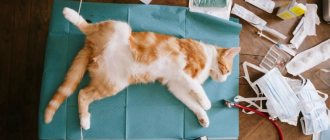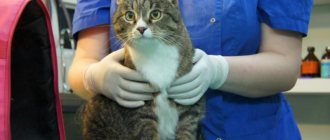A cat that lives at home periodically “delights” its owners with loud, heart-rending screams, signaling the onset of mating season. With its behavior at this time, any, even the best cat in the world is capable of wearing out the entire nervous system of the household. There is a solution to this problem that will save the owner from the animal’s inappropriate behavior and its consequences - this is cat castration.
Castration is a surgical or non-surgical intervention in a male’s body to remove the gonads. The procedure has both advantages and disadvantages, because in any case it will affect the future quality of life of both the cat and its owners.
Pros and cons of castration
global $ads_google; //data-ad-slot=”2475549904″ $ads_google = empty($ads_google) ? false : true; ?> if ($ads_google == false) {?>
$ads_google = true; ?> } ?>
Often the reason for castration of a cat is not only his urgent demand to continue his family, but also an active desire to mark territory. To prevent the furry friend from causing such problems, an operation is performed.
This leads to obvious advantages of the procedure:
- there is no reason to mark territory;
- no excessive aggression;
- absence of loud demands from the cat;
- reducing the risk of genitourinary diseases;
- increasing lifespan.
We must not forget about the disadvantages :
- It is possible that a cat with loss of gonads acquires an increased appetite. This can lead to obesity and health problems;
- perhaps due to changes in hormonal balance, a decrease in the activity of the animal, which is also fraught with obesity;
- when performing surgery on adults or elderly males, sometimes difficulties arise with the functioning of the cardiovascular system;
- if castration was carried out at the wrong time, then not only the testes, but also the pituitary gland take over the production of sex hormones: the operation becomes useless, and all the “cute” manifestations of the mating season continue.
But if the animal is healthy, the cat is castrated at the appropriate time, and the owners strictly monitor the pet’s balanced diet, the disadvantages do not manifest themselves.
Is it worth doing?
Pros:
- Change in behavior, lack of aggression;
- The cat stops marking his territory. Even if the instinct persists for some time after the operation (this is possible with late castration), the smell of urine becomes less pungent;
- The animal will not strive to leave its home - the risk that the cat will run away for a walk is reduced;
- The risk of developing malignant genital diseases is reduced several times.
Consequences (cons):
- The risk of the operation itself, performed under general anesthesia. To reduce it, do not neglect preparatory measures, carefully choose a clinic and veterinarian. Do not forget about a preliminary consultation with a veterinarian, choose modern anesthesia and procedure techniques.
- Risk of postoperative wound infection. Follow all doctor's recommendations, treat the wound, and prevent scratching and licking. If infected, contact your doctor immediately for treatment.
- Risk of pet obesity. After surgery, provide your cat with more active physical activity. Pay enough attention to your diet - reduce the serving size. After consulting with a veterinarian, switch the cat to specialized food for castrates.
When to castrate a cat
To answer the question about the appropriate time for castration, you need to understand when the organs and systems of the body complete their formation.
This happens at about one year, but physiologically the cat becomes sexually mature at six months. Therefore, 6 months is the earliest time to castrate a cat.
.
If the operation is performed before six months, then there is a high probability that the cat will develop urolithiasis (this is especially true for Persians, Himalayan cats, British cats and Scottish Fold breeds), because the urethra is not fully formed. The testes of some males at this age may still not be in place, and this is a significant problem for surgical castration.
You don’t have to wait long: the procedure performed at the age of 7-9 months is easier and more successful.
In any case, a preliminary consultation at a veterinary clinic is required.
At what age to castrate
Veterinarians recommend castrating cats starting at the age of 5-7 months. This is the age at which cats begin puberty. It is important to understand that at this age kittens can already impregnate a cat (including, for example, a littermate). The speed of puberty is individual for everyone, but if there is a risk of getting unwanted offspring, there is no point in postponing castration to a later date. For cats, there are no barriers to impregnation of close relatives, including mother and sisters - unfortunately, doctors are sometimes faced with the incredible amazement of owners who believed that the cat “can’t possibly be pregnant” because the uncastrated cat with whom she lives - her brother. Or son. Or a grandson. Cats are not people, and the only sign that determines the possibility of choosing a sexual partner is the onset of puberty.
In some cases, earlier castration (from 3 months of age) may be recommended. Carrying out the operation at this age is widely practiced in Europe and America, for the sale of pet-class cats from nurseries, that is, not intended for further use in breeding work. Breeders give already neutered animals to their owners (including protecting them from illegal breeding and damage to the line). In some cats, puberty may begin already at this age (this is especially true for Oriental breeds), which in turn can lead to undesirable consequences. There are concepts of puberty and physical maturation - during the onset of puberty, animals are already capable of fertilization, but the body is not yet ready to bear kittens without health consequences until the onset of physical maturation, the complete closure of growth zones. There is a possibility that early castration has an effect on the formation of the musculoskeletal system, however, the vast majority of such studies are devoted to dogs; there is still very little data on cats and they are quite contradictory.
Such early castration, according to numerous studies, does not affect the likelihood of developing urolithiasis, nor the narrowing or stricture of the urethra (similar information can be found in many articles, but it does not correspond to reality, in particular, stricture is a narrowing of the urethra due to inflammation ). The level of risks with early castration is the same as with later castration, and is primarily associated with anesthesia and anesthetic risks. The operation itself is considered simple, and (unlike sterilization of cats) is not abdominal (does not require cutting into the abdominal cavity). The difficulty of providing anesthesia does relate to the size of the animal, including simply in terms of equipment requirements - veterinary medicine quite often uses instruments and supplies from human medicine intended for newborns, but even the smallest children are usually larger than three-month-old kittens. Nevertheless, this is possible, and the task of the owner and the doctor is to assess the possible risks of both delaying the castration procedure and performing it at this age.
There are a number of studies confirming the relationship between castration and an increased risk of developing urolithiasis in cats. These same studies usually show little or no relationship with age at neutering. This may be explained by the fact that the cats that are brought in for appointments are mostly neutered, and any representatives of domestic cats have a high risk of developing lower urinary tract diseases, which leads to such statistics. For a cat, the issue of preventing urolithiasis is indeed very important. The main method of such prevention is to control the density of urine and dilute the urine. The cat is originally a subtropical animal and well adapted to save water. Different animals of this climate zone have different adaptations for this (everyone knows about the humps of camels or the large ears of the fennec cat). In cats, this adaptation lies primarily in the increased concentrating ability of the kidneys. That is, if there is little water, the kidneys will filter the water back as much as possible, while in dogs, for example, the urine will still remain quite diluted. For cats, this can lead to a disturbance in the sense of thirst - that is, the body does not have enough water, and normally the cat should want to drink. But since the kidneys in this case can begin to concentrate urine, irritation to the thirst center will not occur and you will not want to drink. As a result, the cat will experience increased density of urine, which creates very favorable conditions for the crystallization of stones. This is not typical for all cat representatives, but if the cat drinks little, the only safe method of prevention is to increase water consumption. The easiest way is to introduce a wet diet or mixed feeding (if the cat eats dry food). You can also soak the food and add flavoring additives to the water (such water needs to be changed very often). It is recommended to place several bowls of water at home, close to places where the cat likes to rest. A bowl of water next to a bowl of food can simply be perceived as tasteless food - in nature, cats do not drink after eating; the liquid received with food is enough for them.
A clear indicator of the onset of puberty, always clearly visible to the owner, are the marks. As soon as the cat begins to leave small, very strong-smelling puddles all over the house, including in the most inappropriate places, puberty has begun, and you can castrate him. Even if he has not yet reached the average deadlines indicated at the beginning of this article.
If the cat is the only pet in the house, or the other cats are sterilized, there is no need to ensure that the apartment is protected from marks (as, for example, in rented housing) - it is better to castrate cats at the age of 5-7 months. It is also quite possible to neuter adult animals and older cats. For older animals, the anesthesia required for this operation is not contraindicated in itself - everything will very much depend on the individual characteristics of the cat and the presence of concomitant diseases. A healthy 10-year-old cat will have much fewer contraindications and requirements for anesthesia than, for example, a one-and-a-half-year-old cat with congenital pathologies of the kidneys or heart. Castration at this age may be necessary for the development of a number of diseases - with neoplasm of the testes, for example.
Another important change that can occur after castration is the gain of excess body weight. This, in turn, leads to a decrease in activity and an increased risk of developing a number of diseases (diabetes, lipidosis, the risk of developing urolithiasis increases). Why is this happening? When the level of sex hormones decreases, the number of calories consumed by the cat’s body may decrease and the feeling of satiety may be impaired. It’s easy to solve this problem - just switch your pet after castration to a lower-calorie diet (this could be a specialized diet for castrated cats, for example). The problem arises not because of the fact of castration itself, but because of the excess calories that the cat receives. Very often, it is precisely because of the gain of excess body weight that the animal’s behavior changes - activity and playfulness decrease, the cat may experience pain and therefore be reluctant to move. These are changes in behavior that are often considered directly related to castration - however, in most cases they are associated with obesity, and when the cat is brought into ideal condition, mobility and the desire to play return to full extent.
Breeding cats are also often castrated after reaching reproductive age, including in order to prevent the development of diseases and prolong their life.
Types of castration
Surgical and non-surgical methods are used.
Surgical methods:
- Open method - the scrotum is greatly stretched and an incision is made. The testis is removed, the vaginal membrane is freed from it using scissors. The spermatic cord is removed and tied to itself. The same is done with the second testis, after which they are removed.
- With the closed method, the tunica vaginalis is not opened, but only an incision is made to remove the testis and the tunica vaginalis from the scrotum. A ligature is applied to the spermatic cord and cut off. The skin of the scrotum is not sutured.
- The bloodless method or castration without removing the testicles consists of squeezing the spermatic cords with special forceps, after which, after 5 months, they are reabsorbed.
- Vasectomy is a gentle method of sterilization: the seminiferous tubules are partially destroyed, which serves as an obstacle to sperm entering the penis. The testes continue their work, and the cat continues to demand a female, but cannot continue the race.
Non-surgical methods do not involve removing the testicles. This includes chemical castration in the form of injections, tablets or the introduction of a Suprelorin implant.
Preparing a cat for castration
Careful preparation of the animal is mandatory: the success of the operation largely depends on this. If you ignore the veterinarian’s instructions, you may experience health complications and, as a result, additional financial losses.
It is important to follow a strict diet, as anesthesia can cause a gag reflex. The male is not fed for 10-12 hours before the start of the procedure, which will prevent vomit from entering the respiratory tract. Water is not given 4-6 hours before surgery.
global $ads_google; //data-ad-slot=”2475549904″ $ads_google = empty($ads_google) ? false : true; ?> if ($ads_google == false) {?>
$ads_google = true; ?> } ?>
The cat should not have any diseases or health problems that could be a contraindication to castration.
A week before the operation, the cat is dewormed, and the day before it is washed with zoo shampoo.
Castrate a cat at home
Like spaying a cat, neutering can be done at home.
The arriving veterinarian does an examination and, in case of problems, gives answers to all questions. If there are no contraindications, the cat is given anesthesia. After it comes into force, the operation begins and lasts up to 20 minutes.
Then the animal comes out of anesthesia, and the veterinarian once again advises the owners about possible difficulties and gives recommendations for caring for the cat after the operation.
Postoperative period
In order for the cat to recover quickly and successfully, it is worth taking good care of it. The first and most important thing is home care after returning from the clinic.
Home care
The owner’s actions depend on how and at what age the operation was performed. Only the veterinarian who performed the procedure can tell you in detail what needs to be done. Deciding on your own how to treat a wound is strictly prohibited.
Typically care consists of the following:
- in the first few hours, ensure that the cat recovering from anesthesia is not injured;
- do not give him food in the first 8-12 hours after the operation so that he does not vomit;
- make sure that the cat does not pee - in the first day he cannot always control himself;
- protect the animal from disturbance, noise and drafts;
- on the second day, start complementary feeding with new food for castrati;
- Do not let outside for 48 hours.
By following these rules, you will help your cat recover quickly and without complications.
Caring for a cat after castration
How long does it take for a cat to recover from anesthesia? Depends on what kind of drug was used. In any case, you need to monitor the cat’s behavior after castration : the animal will experience stress, so you will definitely need to show it affection and attention. A cat who is restless after neutering will feel more confident if the owner holds him on his lap, pets him and talks to him.
After the anesthesia wears off, the cat can sleep for several hours. The awakened animal is usually weakened and disoriented. If a cat shows aggression against this background, then it is quite capable of causing injury to itself and its owner. It is important to be nearby at this moment and calm the pet. This behavior may be associated with dizziness and nausea.
Anesthesia has a depressing effect on thermoregulation processes in the body, so the operated cat is placed in a warm place away from drafts.
Immediately after the pet gets up, it will rush to look for water, so the bowl with it should stand next to the rookery.
The toilet should be within the animal's access area after anesthesia.
If during the operation the cat was not given saline solution or an “artificial tear” drug, then dryness on the cornea will be eliminated by lacrimation.
The wound will need to be treated: if dirt appears, they are removed with a damp cotton pad and treated with an antiseptic. It would be better to put an Elizabethan collar on the cat's neck - it will not allow the animal to damage the seams. After 4-5 days the device is no longer required.
In just a few days the cat will return to normal and recover.
Feeding castrated cats
After castration, very little time should pass, the pet’s body will be rebuilt, and the character of the furry friend will become softer. He will be less and less drawn to street walks, but his appetite may increase noticeably.
To prevent a once powerful healthy cat from turning into a fluffy dumpling of particularly large sizes, it will be necessary to reduce the total calorie intake by 25-30%.
Food for neutered cats does not include fish dishes, and it is better to avoid dry non-specialized food altogether. Fried, salty, fatty foods are not recommended.
An excellent healthy food would be porridge and boiled lean meat. There is a ready-made balanced food for neutered cats.
Possible complications
Some owners are afraid of the consequences of surgery that may happen to their pet.
Obesity
There is a chance that a cat will gain weight after castration. But this can be easily avoided by understanding the nature of this phenomenon. The animal gets fat because it has nowhere to spend energy. Previously, he looked for the cat day and night, but now he only eats and sleeps. In order for the cat to always be in shape, the owner needs to take care of this:
• Provide exercise for the cat.
Buy toys, spend time with him, play actively. You can get a second cat so that he has someone to play with. It is very useful to take the animal outside. You need to understand that in the wild, cats lead very active lives.
• Feed less.
Reducing the diet will not harm the cat. Castrated animals need 25-30% less energy, as their metabolism changes. Food should be less caloric. By choosing the right diet and portions, you can control your pet’s weight.
Urolithiasis disease
Castration itself is not the root cause of urolithiasis (UCD). But it can aggravate and accelerate its development. UCD is the deposition of minerals in the bladder/kidneys due to excess, deposits or improper metabolism. It must be remembered that predisposing factors are obesity and a sedentary lifestyle.
If you walk and play with the animal, as well as control its weight and diet, you can reduce the risk of developing urolithiasis to a minimum. If you overfeed your pet after castration, this will contribute to the deposition of minerals. Low fluid intake also has a negative effect; water should always be available to the cat.
If a cat marks after castration
global $ads_google; //data-ad-slot=”2475549904″ $ads_google = empty($ads_google) ? false : true; ?> if ($ads_google == false) {?>
$ads_google = true; ?> } ?>
This question arises periodically, and there is only one recommendation: find the reason for the tagging.
In the event of such an incident, the animal is brought for examination to a specialist, since the examination may reveal a poorly performed operation, or the cat turned out to be cryptorchid and its testicles are not in the abdominal cavity.
The solution to the problem may be a repeat operation - the testes need to be removed, as they produce sex hormones.
Another reason for leaving an unpleasant smell in the apartment from marks is the cat’s banal bad manners; here you will need to study tips on how to wean a cat from marking its territory.
There are animal psychologists who can help desperate owners cope with their cat’s desire to mark.
How much does it cost to cast a cat?
Each veterinary clinic sets its own prices for surgical or non-surgical intervention in the animal’s body for the purpose of castration.
The average price for castration of cats is 2,000 rubles, but this amount does not always include anesthesia, examination-consultation, hospital, and post-operative care. Accordingly, the price increases depending on the clinic.
Castrating a cryptorchid cat will be more expensive: cats with testes in the subcutaneous tissue cost about 2500-3500 rubles, and if the testes are located in the abdominal cavity, 3100-4500 rubles.
Take care of the health of your cats, and they will remain your faithful friends for many years.
Carrying out the operation
Veterinarians recommend treating the cat for parasites before castration. It is also advisable that the animal be vaccinated. At least a month must pass since the last vaccination: a vaccinated cat has a faster recovery period, and the body copes with possible infections more successfully. If it is unknown whether the cat has been vaccinated or not, then a special serum is injected to develop 2-week immunity.
Castration is a serious surgical intervention on an animal’s body. Before surgery, the cat should be examined by specialists - a cardiologist and a therapist - for chronic diseases. In some cases, additional studies will be required - urine analysis, general and biochemical blood tests. Only healthy animals with good appetite and regular bowel movements are allowed for surgery.
Stages of castration:
- Specialists conduct a clinical study of your pet. Breathing, heart function, body temperature and the condition of the mucous membranes are checked.
- The veterinarian administers medications that help the animal’s body tolerate the operation more easily (premedication).
- The doctor gives an injection that puts the cat into artificial sleep, that is, anesthesia.
A cat under anesthesia's eyes remain open
- The cat is castrated - an incision is made in the scrotum, the testes are removed, a ligature is applied to the spermatic cord to prevent bleeding, and the testes are surgically removed. Sometimes doctors use a seamless castration method, so there are no stitches on the scrotum, and therefore there is no need to remove them either.
Anesthesia causes a gag reflex in cats. Therefore, before castration, “fast” the cat for 10–12 hours. In some cases, a laxative should be given the day before castration. It is important that the pet has an empty stomach before the operation: if the cat becomes sick before or after the operation, he may choke on vomit. Access to water is limited 4 hours before surgery. If these conditions are not met, notify the veterinarian and prepare wipes.
For the operation you need to take a towel and blanket for the cat, your documents and your pet’s passport.
Castration options
There are three ways to castrate cats: surgical, chemical and medicinal.
Surgical castration
The most common is surgical. The operation takes 5–7 minutes. The procedure is performed under anesthesia, local or general, depending on the physical and emotional state of the furry patient. Large or aggressive cats are given sedatives before surgery.
Some cats are prone to allergies to anesthesia; in this case, it is better to find a veterinarian who will perform the operation under local anesthesia.
Opponents of surgical castration cite the fact that surgery is an injury. And that cats have a hard time withstanding anesthesia.
Anesthesia is a very individual thing. Only an experienced veterinarian can correctly calculate the required dose of the drug. The breed of the animal, weight, condition of the nervous system and heart matter. Even the mood. My first deliberately acquired cat was 9 months old when it was decided to castrate him. There were no veterinarians we knew, so we went to the nearest clinic. All preparation rules were followed. But the young doctor did not calculate the amount of sleeping pills. As a result, Pudik recovered from anesthesia only at the end of the second day and almost died. I strongly recommend that you contact only familiar, trusted veterinarians.
Fixators are used to perform a successful operation
Chemical castration
Chemical castration of cats is not a surgical procedure. During its implementation, the functions of the testes are suppressed by the effects of radiation on the reproductive organs. The radiation dose is individual for each cat, i.e. it must correspond to the type of animal and is calculated depending on weight, age, and health status.
Chemical castration of cats, as scientific research confirms, is a completely safe and reliable method. However, some experts still oppose this type of intervention in the reproductive functions of an animal, based on the fact that chemical castration may change the cellular structure of the kidneys and adrenal glands.
I was told that there is supposedly some kind of chemical castration of cats. They are given an injection (implant with melatonin) directly into the testicles and that’s enough, supposedly that’s it, the cat is neutered for life.
Lozinka
https://mauforum.ru/viewtopic.php?f=37&t=14305
Such murky information usually comes from abroad, often through retelling. There is now a wave of use of GnRH implants abroad. Gonadotropin with a new method of administration - through a capsule shaped like a microchip. Really powerful advertising. And by the way, as opposed to early castration. Maybe there is common sense in what they rely on in their propaganda - the adrenal glands and their problems. But do not forget about the interests of pharmaceutical companies. THOSE. cats and ferrets are given chips containing drugs (hormones). But again, frequency of administration is needed. I think this means that estrus will still be restored, but the ability to bear children is in question. Well, the same goes for males. They'll let you rest for about a year, then depending on your luck. No guarantees. THOSE. potency will be restored. There is NO chemical castration for life.
fabiana
https://mauforum.ru/viewtopic.php?f=37&t=14305
Medical castration
Medical castration is a temporary measure. In this case, no anesthesia or preparation is required. Administration of the drug for a certain period of time (3–6 months) deprives the cat of the ability to fertilize. However, there are also side effects: if under the influence of hormones the pet becomes lethargic or the appetite increases, this effect can persist for the entire 3-6 months.
It is important to note that the constant use of injections can be dangerous in the long term: the risk of developing inflammatory diseases of the genitourinary system increases. But due to the fact that safe hormones administered in small quantities are used for medical castration, complications and undesirable consequences rarely occur.
Covinan is, according to my information, the best of the hormonal drugs that inhibit estrus. But by and large, all these drugs can cause irreparable harm to the animal. I don’t know whether respected members of the forum – professionals – will agree with me, but in my opinion, hormonal medications cannot be considered at all as an alternative to surgery. And also, if you still decide, make sure that the cat is injected with Covinan, and not some cheaper drug, and even intended for humans (depopromone, for example).
Judy
https://forum.mau.ru/viewtopic.php?t=5360
And in general, I wouldn’t compare pencils to oranges (even if I wanted to). I would formulate the topic a little differently, that the thread “Covinan is a good replacement/alternative to contrasex” has less harmful effects on health. So Kuznetsov from the zooforum (in my opinion, it’s still him) said that in 4 years of working with the drug, he did not observe endocrine disorders in cats. I don’t know how many cats he observed, and 4 years is not a long time, but still... There is no guarantee that with CONSTANT exposure to the drug, a cat will not have endometritis/pyometra within 5-10 years. There are no reliable statistics in Russia (only the desperate desire of cat owners). Then you will still have to sterilize the cat, for medical reasons. We must remember that there is such a thing as drug rejection (I observed). Not all cats, of course... and she can tolerate the first injection normally, but 3-4 months after the 2nd, 3rd, 4th, etc. injection, hair loss, redness and perforation of the skin are possible... Depending on your luck...
fabiana
https://forum.mau.ru/viewtopic.php?t=5360
And now the most important thing, for which I am writing. Diagnosis made after sterilization: A. Endometrial hyperplasia in the initial stage. (The doctor did not like the endometrium itself - it is very “hard” - according to her, it is not typical for tissue that has a spongy structure) B. Cystic degeneration of both ovaries (the left one to a greater extent) B. Cystic neoplasm (1 per 0.6) per suspensory ligament of the left ovary All about the consequences of using Covinan in a particular cat.
fabiana
https://forum.mau.ru/viewtopic.php?t=5360
Postoperative care
It is advisable that after the operation the cat remains in the clinic for 1.5–2 hours under the supervision of doctors. The veterinarian will provide qualified assistance in case of complications that anesthesia may cause.
When the cat comes out of a drug-induced sleep, the remaining hormones are excreted along with strong-smelling urine. This is where napkins and a towel will come in handy.
The cat fully recovers from anesthesia within 24 hours
The cat, handed over to its owners after surgery, is under the influence of drugs. To return the tailed patient home, a spacious carrier is prepared. Transport the animal on its side. Under the influence of the drug, the cat's thermoregulation is disrupted: to avoid hypothermia, place a warm heating pad on the back side.
Signs of a normal state of a cat under anesthesia:
- when the eye is exposed to flashlight light, the pupil constricts;
- the cat moves its tail or paws;
- breathes frequently and intermittently.
The cat recovers completely from general anesthesia within 8–24 hours.
After the operation, the animal needs complete rest; for a speedy recovery of the animal, follow the rules:
- Protect your cat from drafts, noise and bright light.
- At this time, his coordination is impaired, so do not place your pet in elevated places to avoid falling and injury.
- The cat may lose appetite, vomit and have convulsions. There is general weakness. These are also normal reactions to the drug.
- Cats are designed in such a way that under the influence of anesthesia their eyes do not close. To avoid them drying out, you need to close your pet’s eyelids from time to time and stock up on antiseptic drops.
- Treat the seams with peroxide and green paint for speedy healing. To avoid infections and damage to the seams, remove the litter from the tray and replace it with pieces of toilet paper.
- On the first day after surgery, put your cat in a diaper with a tail hole. This will help avoid infection and inflammation.
- Do not allow your cat to lick the wound so as not to slow down the healing process. To do this, purchase a special collar from the veterinary pharmacy, which is removed only during feeding.
A special collar is needed to prevent the cat from licking the wound.











